heater CHEVROLET TRACKER 1998 1.G Owners Manual
[x] Cancel search | Manufacturer: CHEVROLET, Model Year: 1998, Model line: TRACKER, Model: CHEVROLET TRACKER 1998 1.GPages: 386, PDF Size: 21.17 MB
Page 132 of 386
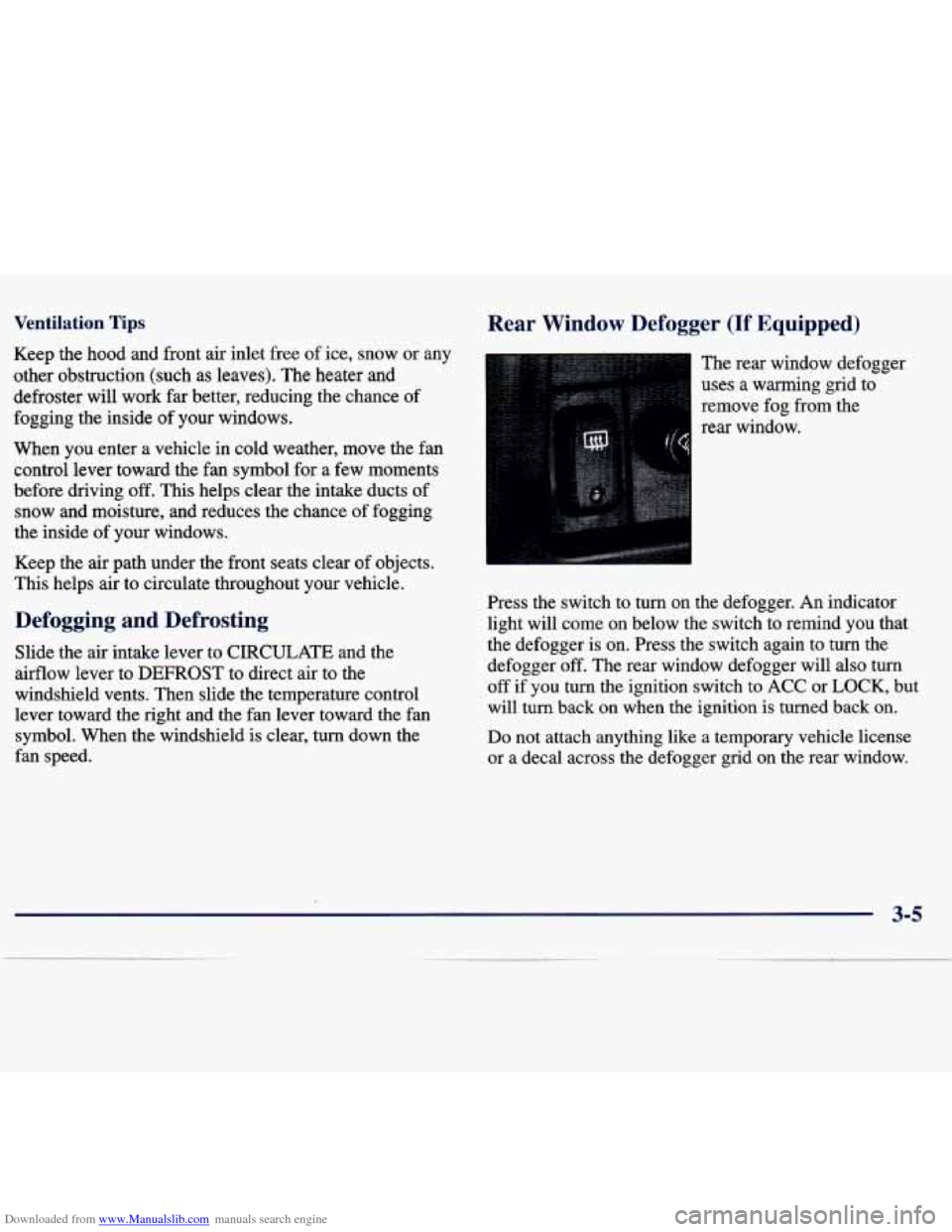
Downloaded from www.Manualslib.com manuals search engine Ventilation Tips Rear Window Defogger (If Equipped)
Keep the hood and front air inlet free of ice, snow or any
other obstruction (such
as leaves). The heater and
defroster will work far better, reducing the chance of
fogging the inside
of your windows.
When
you enter a vehicle in cold weather, move the fan
control lever toward the fan symbol for a few moments
before driving
off. This helps clear the intake ducts of
snow and moisture, and reduces the chance
of fogging
the inside
of your windows. The
rear window defogger
uses
a warming grid to
remove fog from the
rear window.
Keep the air path under the front seats clear of objects.
This helps air to circulate throughout your vehicle.
Defogging and Defrosting
Slide the air intake lever to CIRCULATE and the
airflow lever to DEFROST to direct air to the
windshield vents. Then slide the temperature control
lever toward
the right and the fan lever toward the fan
symbol. When the windshield is clear, turn down the
fan speed. Press the switch to turn on the defogger. An indicator
light will come on below the switch to remind you that
the defogger is on. Press the switch again to turn the
defogger
off. The rear window defogger will also turn
off if you turn the ignition switch to ACC or LOCK, but
will turn back on when the ignition is turned back on.
Do not attach anything like a temporary vehicle license
or a decal across the defogger grid on the rear window.
3-5
Page 188 of 386
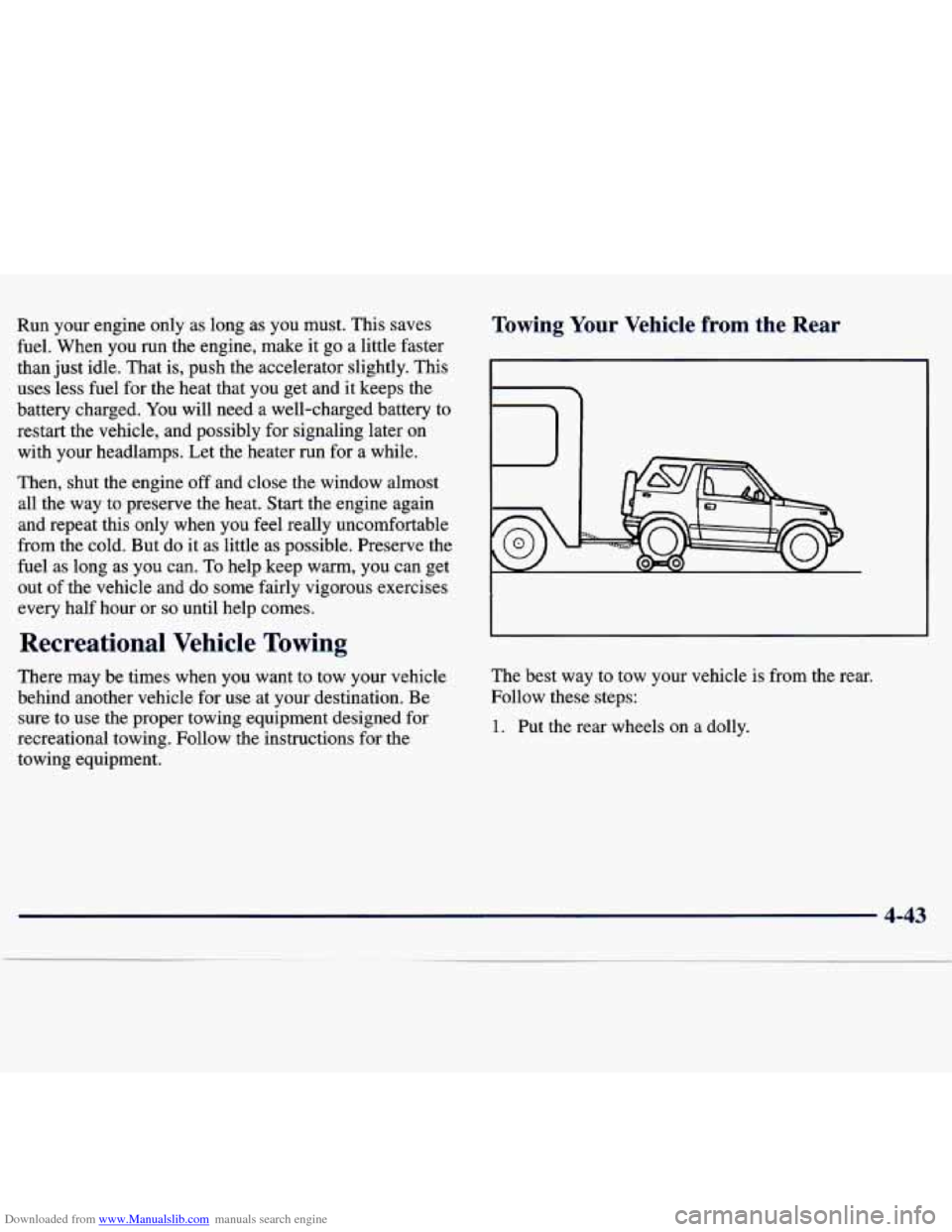
Downloaded from www.Manualslib.com manuals search engine Run your engine only as long as you must. This saves
fuel. When you run the engine, make it
go a little faster
than just idle. That is, push the accelerator slightly. This
uses less fuel for the heat that you get and it keeps the
battery charged.
You will need a well-charged battery to
restart the vehicle, and possibly for signaling later on
with your headlamps. Let the heater run for a while.
Then, shut the engine
off and close the window almost
all the way to preserve the heat. Start the engine again
and repeat this only when you feel really uncomfortable
from the cold. But do it as little as possible. Preserve the
fuel as long as you can. To help keep warm, you can get
out of the vehicle and do some fairly vigorous exercises
every half hour or
so until help comes.
Recreational Vehicln Towing
There may be times when you want to tow your vehicle
behind another vehicle for
use at your destination. Be
sure to use the proper towing equipment designed for
recreational towing. Follow the instructions
for the
towing equipment.
Towing Your Vehicle from the Rear
hl
The best way to tow your vehicle is from the rear.
Follow these steps:
1. Put the rear wheels on a dolly.
4-43
Page 215 of 386
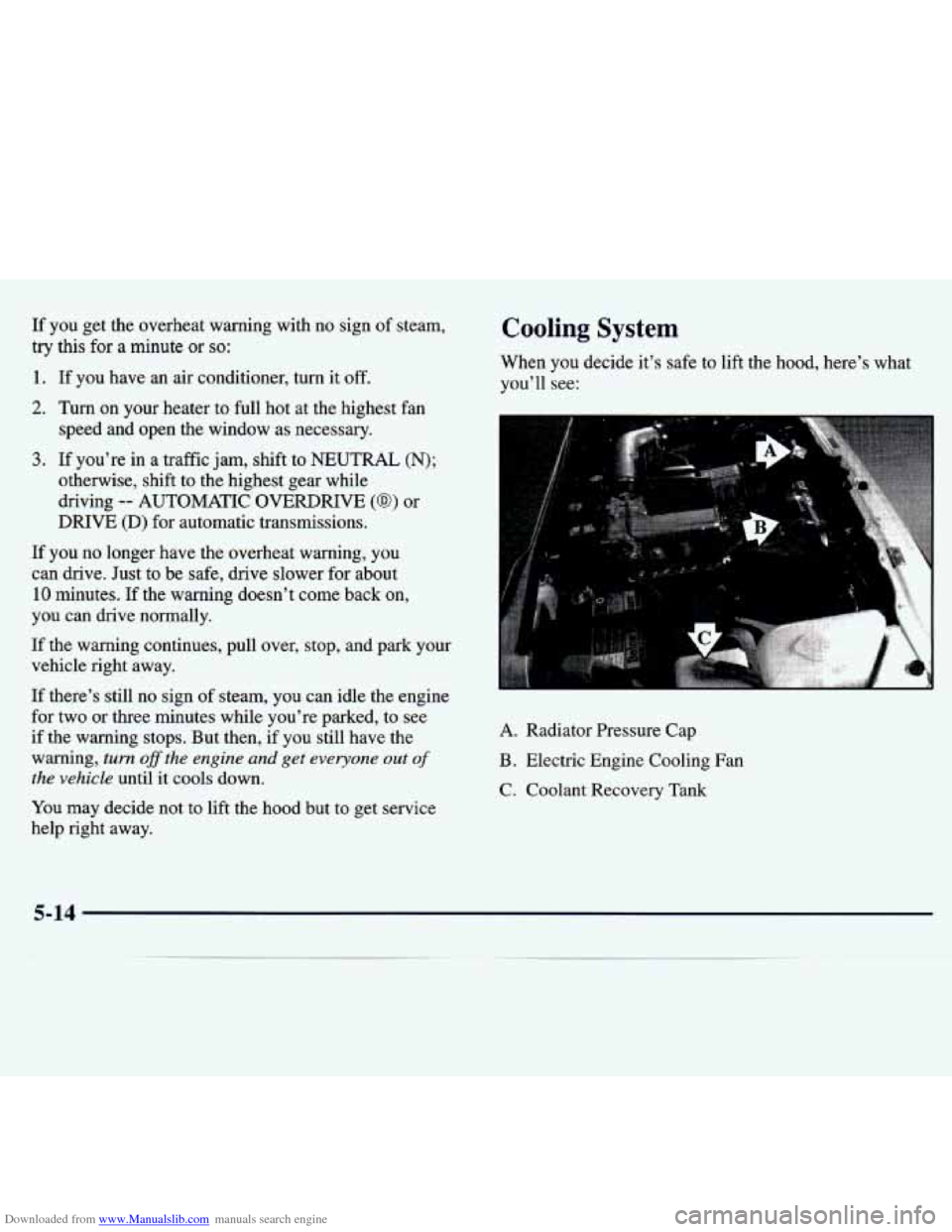
Downloaded from www.Manualslib.com manuals search engine If you get the overheat warning with no sign of steam,
try this for a minute or so:
1. If you have an air conditioner, turn it off.
2. Turn on your heater to full hot at the highest fan
speed and open the window as necessary.
3. If you’re in a traffic jam, shift to NEUTRAL (N);
otherwise, shift to the highest gear while
driving
-- AUTOMATIC OVERDRIVE (a) or
DRIVE (D) for automatic transmissions.
If you no longer have the overheat warning, you
can drive. Just to be safe, drive slower for about
10 minutes. If the warning doesn’t come back on,
you can drive normally.
If the warning continues, pull over, stop, and park your
vehicle right away.
If there’s still no sign of steam, you can idle the engine
for two or three minutes while you’re parked, to see
if the warning stops. But then,
if you still have the
warning,
turn ojjfthe engine and get everyone out of
the vehicle until it cools down.
You may decide not to lift the hood but to get service
help right away.
Cooling System
When you decide it’s safe to lift the hood, here’s what \
you’ll see:
A. Radiator Pressure Cap
B. Electric Engine Cooling Fan
C. Coolant Recovery Tank
5-14
Page 216 of 386
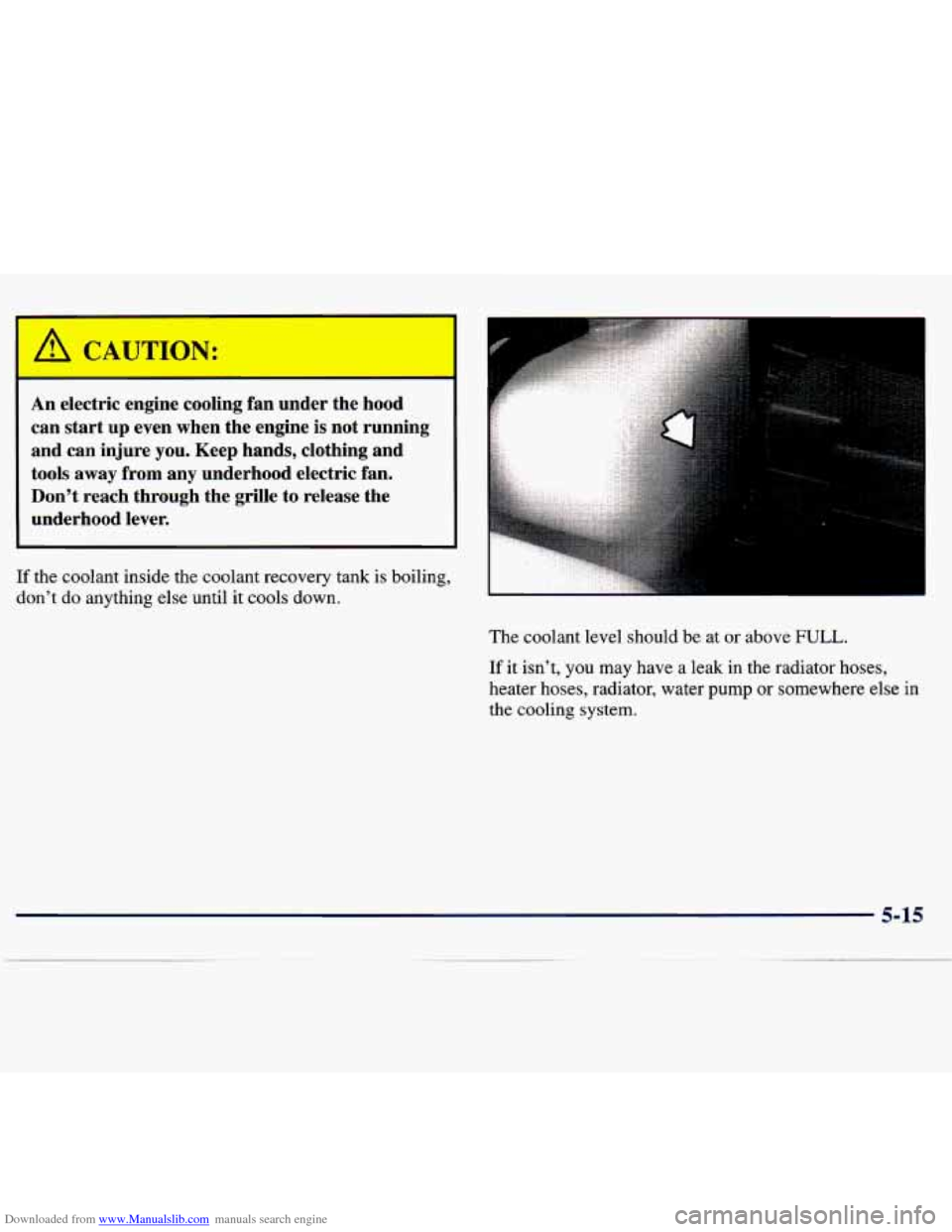
Downloaded from www.Manualslib.com manuals search engine I
An electric engine cooling fan under the hood
can start
up even when the engine is not running
and can injure
you. Keep hands, clothing and
tools away from any underhood electric fan.
Don’t reach through the grille
to release the
underhood lever.
If the coolant inside the coolant recovery tank is boiling,
don’t
do anything else until it cools down.
The coolant level should be at
or above FULL.
If it isn’t, you may have a leak in the radiator hoses,
heater hoses, radiator, water pump or somewhere else in
the cooling system.
5-15
Page 217 of 386
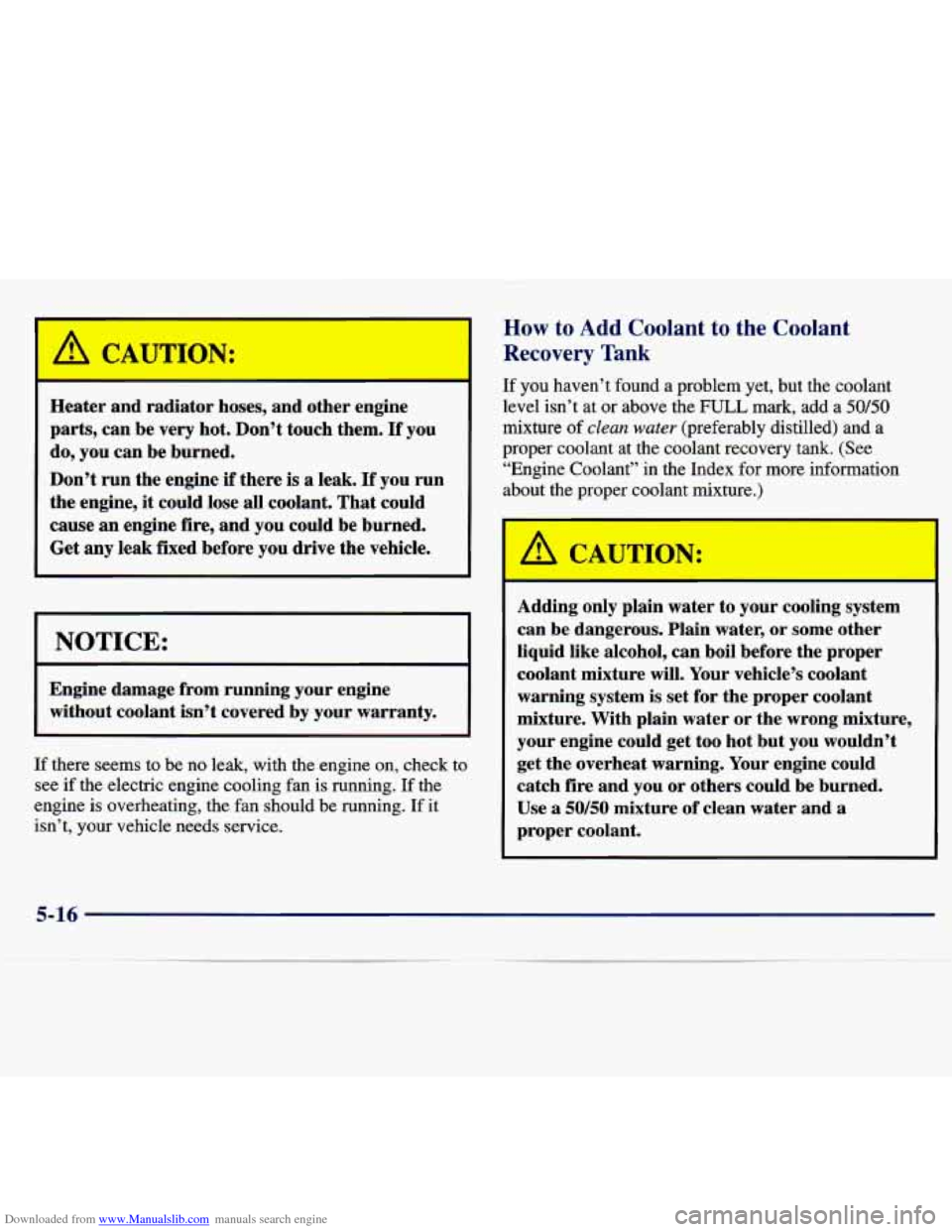
Downloaded from www.Manualslib.com manuals search engine I A
A C ,U ION:
Heater and radiator hoses, and other engine
parts, can be
very hot. Don’t touch them. If you
do, you can be burned.
Don’t run the engine if there is
a leak. If you run
the engine, it could lose all coolant. That could
cause an engine fire, and you could be burned.
Get
any leak fixed before you drive the vehicle.
NOTICE:
Engine damage from running your engine
without coolant isn’t covered by your warranty.
If there seems to be no leak, with the engine on, check to
see if the electric engine cooling fan
is running. If the
engine is overheating, the fan should be running. If it
isn’t, your vehicle needs service.
How to Add Coolant to the Coolant
Recovery Tank
If you haven’t found a problem yet, but the coolant
level isn’t at or above the
FULL mark, add a 50/50
mixture of clean water (preferably distilled) and a
proper coolant at the coolant recovery tank. (See
“Engine Coolant” in the Index for more information
about
the proper coolant mixture.)
Adding only plain water
to your cooling system
can be dangerous. Plain water, or
some other
liquid like alcohol, can boil before the proper
coolant mixture will. Your vehicle’s coolant
warning system is set for the proper coolant
mixture. With plain water or the wrong mixture,
your engine could get too hot but you wouldn’t
get the overheat warning. Your engine could
catch fire and you or others could be burned.
Use a 50/50 mixture of clean water and a
proper coolant.
5-16
Page 218 of 386

Downloaded from www.Manualslib.com manuals search engine NOTICE:
In cold weather, water can freeze and crack
the engine, radiator, heater core and other parts.
Use the recommended coolant and the proper
coolant mixture.
A CAUT,JN:
You can be burned if you spill coolant on hot
engine parts. Coolant contains ethylene glycol
and
it will burn if the engine parts are hot
enough. Don’t spill coolant on
a hot engine.
When the coolant in the coolant recovery tank
is at or
above the
FULL mark, start your vehicle.
If the overheat warning continues, there’s one more
thing you can try.
You can add the proper coolant
mixture directly
to the radiator, but be sure the cooling
system is cool before you do it.
5-17
.
Page 262 of 386

Downloaded from www.Manualslib.com manuals search engine NOTICE:
If you use an improper coolant mixture, your
engine could overheat and be badly damaged.
The repair
cost wouldn’t be covered by your
warranty.
Too much water in the mixture can
freeze and crack the engine, radiator, heater core
and other parts.
If you have to add coolant more than four times
a year,
have your dealer check your cooling system.
I NOTICE:
If you use the proper coolant, you don’t have to
add extra inhibitors or additives which claim to
improve the system. These can be harmful.
Checking Coolant
When your engine is cold, the coolant level should be at
LOW, or a little higher. When your engine
is warm, the
level should be up to FULL, or
a little higher.
Adding Coolant
If you need more coolant, add the proper coolant
mixture
at the coolant recovery tank.
Page 296 of 386
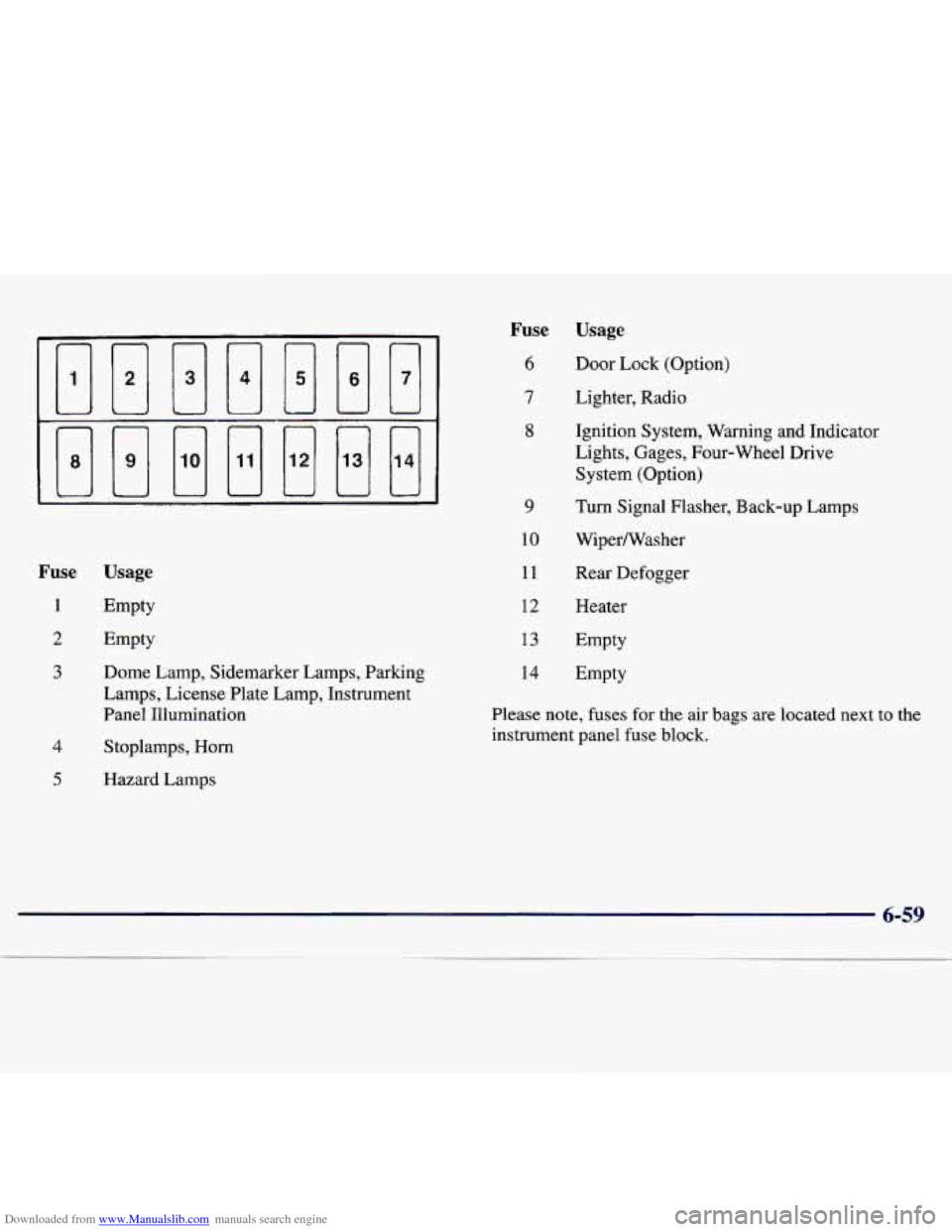
Downloaded from www.Manualslib.com manuals search engine Fuse Usage
1 Empty
2
3
4
5
Dome Lamp, Sidemarker Lamps, Parking
Lamps, License Plate Lamp, Instrument
Panel Illumination
Stoplamps,
Horn
Hazard Lamps
Fuse
6
7
8
9
10 11
12
13
14
Usage
Door Lock (Option)
Lighter, Radio
Ignition System, Warning and Indicator Lights, Gages, Four-wheel Drive
System (Option)
Turn Signal Flasher, Back-up Lamps
Wiperwasher
Rear Defogger
Heater
Empty
Empty
Please note, fuses
for the air bags are located YI IO me
instrument panel fuse block.
6-59
__
Page 297 of 386
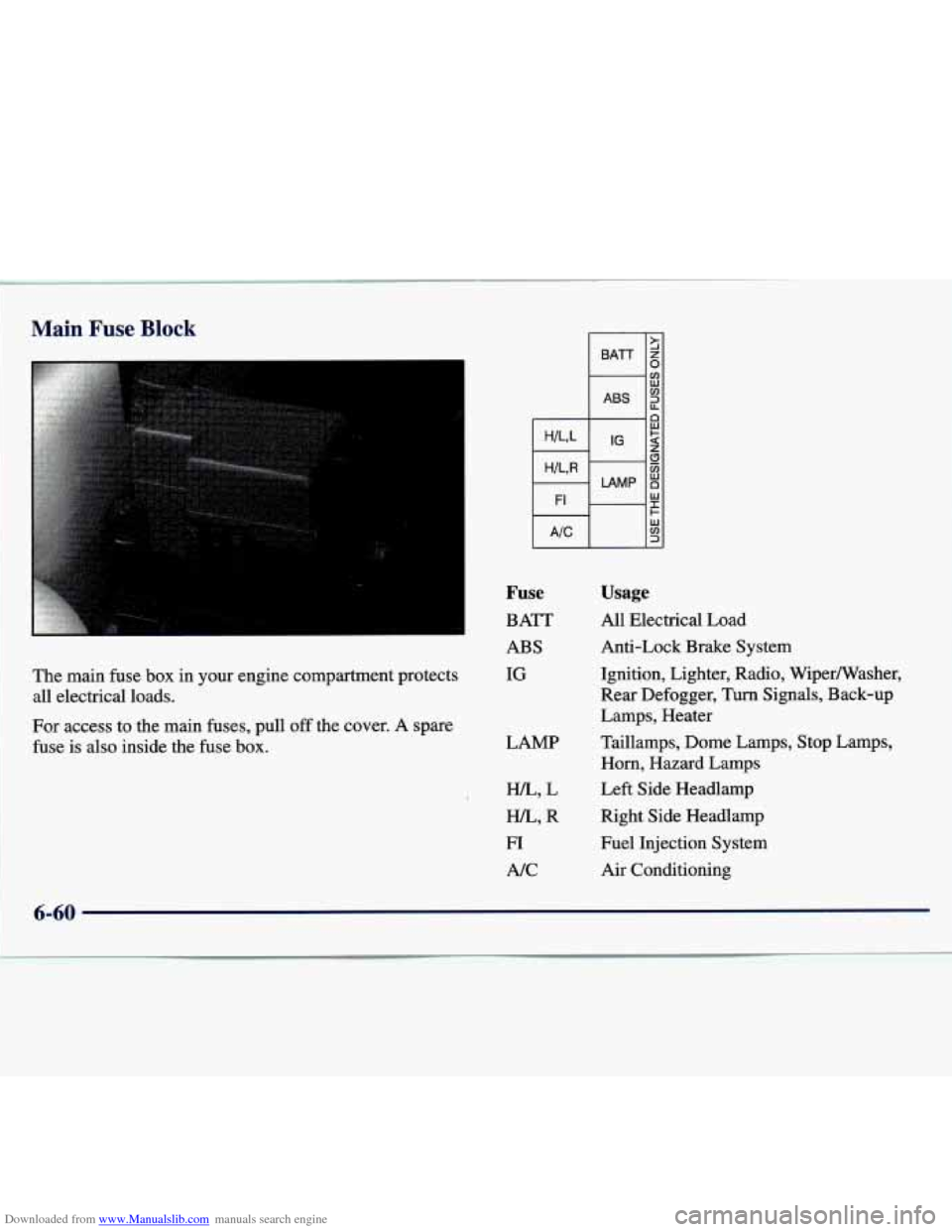
Downloaded from www.Manualslib.com manuals search engine 1
Main Fuse Block
The main fuse box in your engine compartment protects
all electrical loads.
For access to the main fuses, pull
off the cover. A spare
fuse is also inside the fuse
box.
Fuse
BATT
ABS
IG
LAMP
Usage
All Electrical Load
Anti-Lock Brake System
Ignition, Lighter, Radio, WiperNasher,
Rear Defogger,
Turn Signals, Back-up
Lamps, Heater
Taillamps, Dome
Lamp, Stop Lamps,
Horn, Hazard Lamps
Left Side Headlamp
Right Side Headlamp
Fuel Injection System
Air Conditioning
6-60